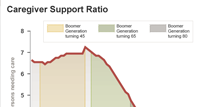
05 Sep The Future Supply of Family Caregivers

Shakespeare declared, “What’s past is prologue.” This statement captures the demographic trends that predict the future supply of family caregivers in the United States. The past may be prologue, but the future ability of families to care for their aging members who encounter disabilities will be a “brave new world,” to quote the Bard again.
In a recently released paper, we defined a “caregiver support ratio” as the number of potential caregivers ages 45-64 for each person age 80 and older. We use this support ratio to document the projected declining availability of family caregivers to provide long-term services and supports (LTSS) over the next few decades. The figure above tracks this ratio for the period from 1990 to 2050. It charts the future availability of family caregivers as boomers age from the peak caregiving years into the high-risk years of late life, and shows:
- The period from 1990 to 2010 was marked by boomers aging into the prime caregiving years. As a result, the caregiver ratio was high and increased slightly from 6.6 to 7.2 potential caregivers ages 45-64 for every person age 80-plus.
- The period from 2010 to 2030 will be a time of transition as boomers progress into old age and the caregiver ratio declines sharply from 7.2 to 4.1 — especially when the oldest boomers begin to reach age 80 in the mid-2020s.
- The period from 2030 to 2050 will include all remaining boomers aging into the high-risk years of 80-plus, and the caregiver ratio will continue to drift downward from 4.1 to 2.9 — less than half the current ratio.
In just 13 years (2026), as the boomers age into their 80s, the change in the caregiver support ratio will shift from a slow decline to a free fall in all 50 states and the District of Columbia. Rapidly increasing numbers of people in advanced old age and shrinking families to provide support to them will demand new solutions to the financing and delivery of LTSS. The past suggests that families will continue as the backbone of support for older loved ones, but the future suggests that family caregivers will themselves require more support to meet the increased stress and burdens that are certain to occur.
The stage has been set, but the play has yet to be written. As the national Commission on Long-Term Care completes its work in the coming weeks, an essential part of its final report should call for a national strategy to support family caregivers. A comprehensive person- and family-centered policy for LTSS would better serve the needs of people with disabilities, support family and friends in their caregiving roles, and promote greater efficiencies in public spending. By addressing these challenges, the commission’s report could be prologue to a better future for a rapidly aging America.
